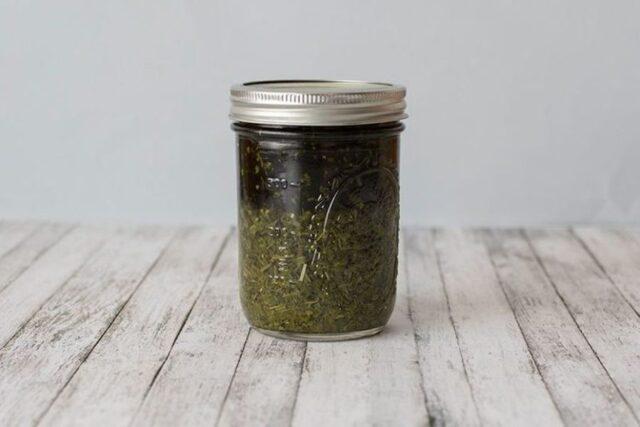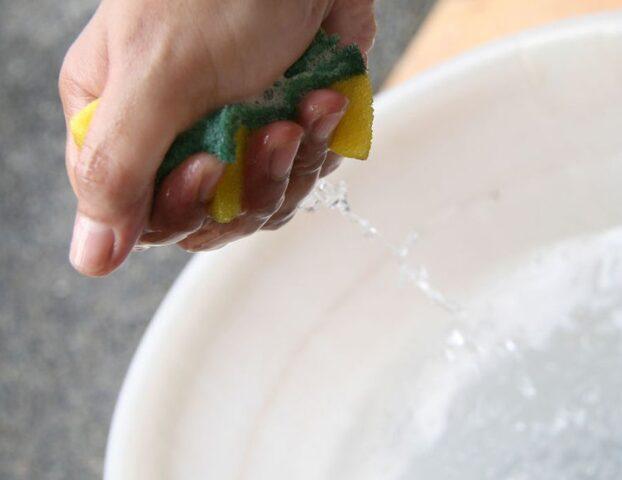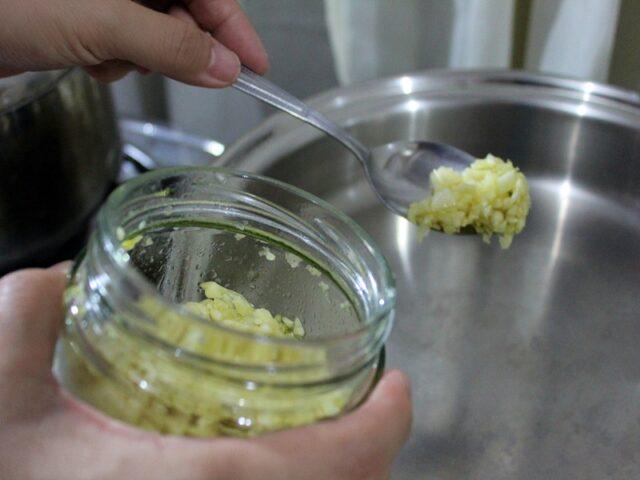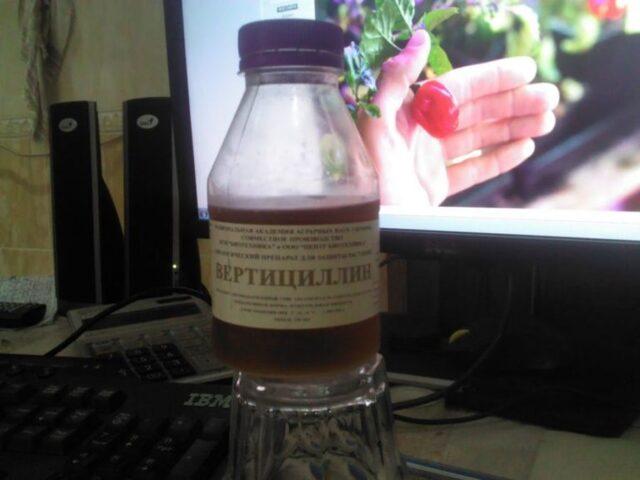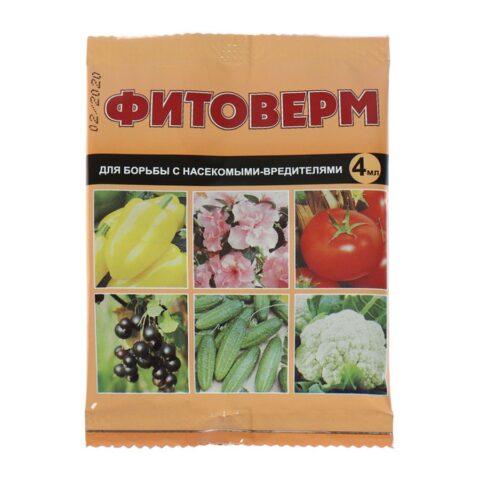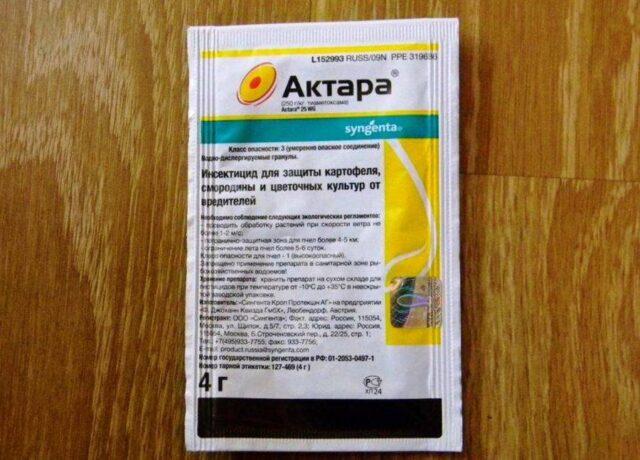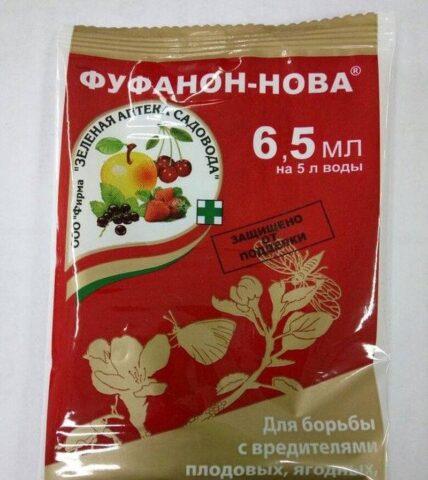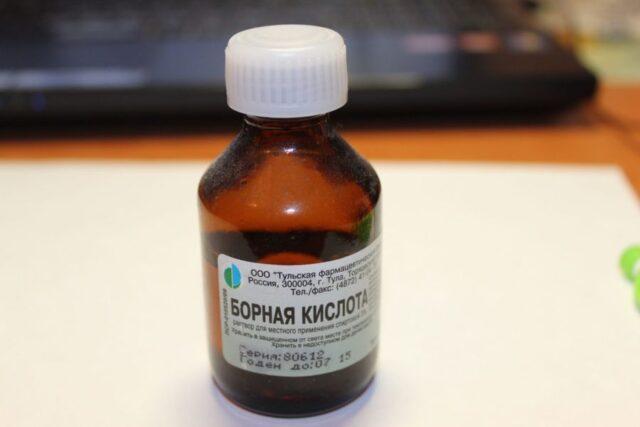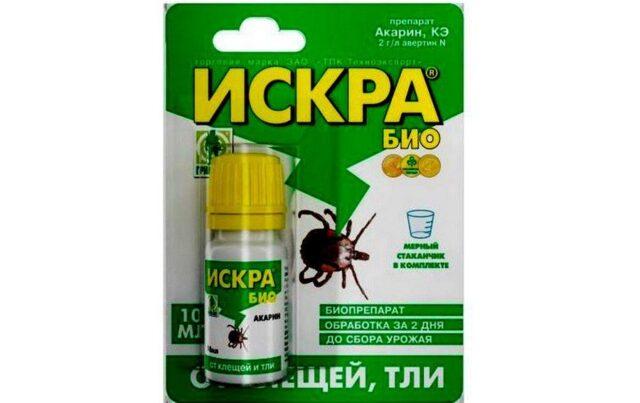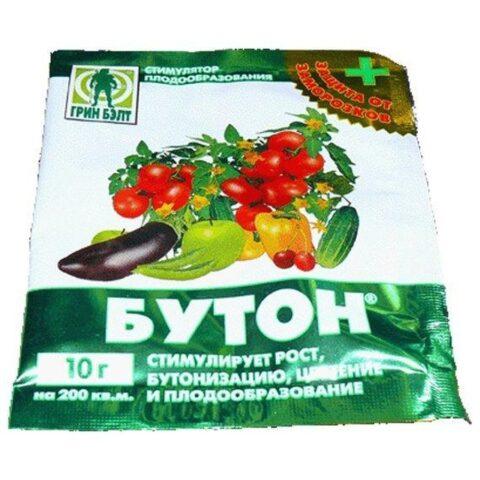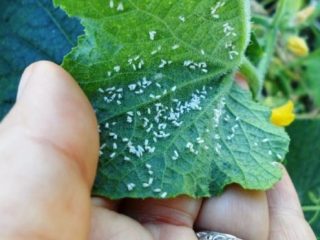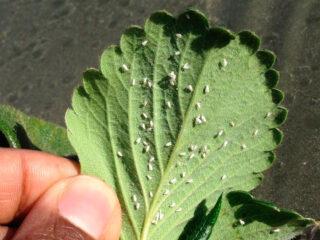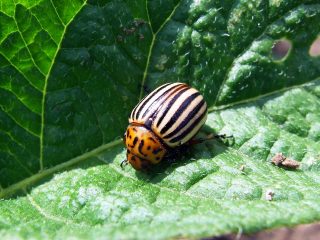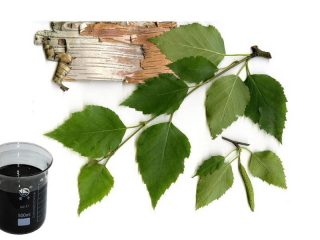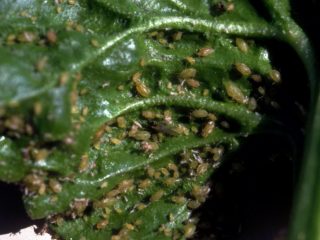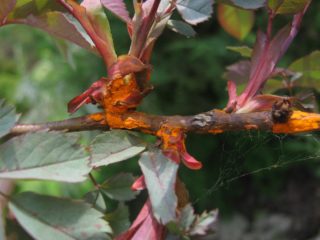Content
- 1 Why is whitefly dangerous for cucumbers?
- 2 What does whitefly look like on cucumbers?
- 3 How to deal with whitefly on cucumbers in a greenhouse
- 4 How to treat cucumbers against whitefly in open ground
- 5 Prevention
- 6 Conclusion
- 7 Reviews on the fight against whitefly on cucumbers in a greenhouse and in open ground
Whitefly on cucumbers can negatively affect the health of plantings and reduce yields. Pest control is carried out in several ways, and great attention is also paid to prevention.
Why is whitefly dangerous for cucumbers?
Small white midges on cucumbers do not always lead to direct destruction of the plantings. But its effect remains negative, even if there are relatively few insects on the leaves. In particular, when infected by a pest:
- cucumber leaves turn yellow, dry out and fall off;
- bush growth slows down;
- productivity decreases;
- Photosynthesis processes are disrupted, as a result of which cucumbers wither and wither.
The whitefly leaves a special secretion on the leaves - the so-called honeydew. Because of this, cucumbers become attractive to ants and other harmful insects, and are more likely to suffer from viruses and fungal infections.
What does whitefly look like on cucumbers?
The whitefly is a small moth-like insect with a light or yellow body and four milky white wings. The length of the parasite does not exceed 3 mm. It lays eggs on the leaves of cucumbers, from which translucent yellowish larvae subsequently hatch and begin to feed on plant sap.
To see the whitefly, you need to carefully examine the lower surface of the plates. Adult pests look like numerous light-colored midges that move when the stem moves. Whitefly larvae look more like yellow-white scales covering the inside of the leaf.
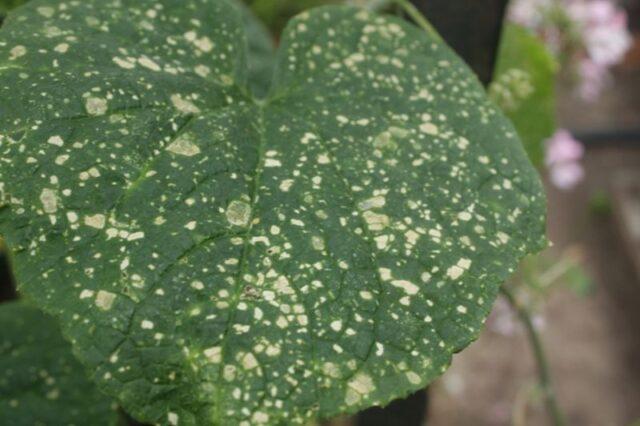
With severe whitefly infestation, whitish, yellow and dark spots appear on the leaves of cucumbers.
How to deal with whitefly on cucumbers in a greenhouse
Most often, whiteflies attack cucumber bushes in a greenhouse, since high temperature and humidity are optimal conditions for the pest. Several methods are used to get rid of insects.
Manual method
If the cucumber bushes are slightly damaged, you can collect the pest manually. They do this in two ways:
- wash the whitefly off the leaves with plenty of warm water, the pressure should be moderate so that the stems do not break;
- wipe the plates with a sponge dipped in soapy water from the outside and inside.
The manual method demonstrates good efficiency. But if conditions in the greenhouse are favorable for the development of the pest, then sooner or later the whitefly will attack the bushes again.
Setting traps
A popular measure to combat whitefly on cucumbers in a greenhouse is to install simple traps.There is no need to buy them in the store; the devices are easy to make with your own hands:
- Sticky bottle. Empty plastic containers are painted orange on the outside, and then glue or a solution prepared from laundry soap and petroleum jelly, taken in equal quantities, is generously applied to its surface. A bright LED is placed inside the bottle and the trap is hung next to the cucumber bushes. A whitefly in the dark will fly towards the light and stick to the surface of the device.
- Container with water. A light bulb painted red or orange is mounted in a small wooden box, and a container of water is placed underneath. The structure is hung next to the cucumbers. The whitefly, flying into the light, gets burned on the light bulb and falls into the prepared water.
The traps look very simple, but show good effect against adult pests. Their use allows you to get rid of approximately 80% of insects in the greenhouse. But at the same time, the remaining pests will still have to be removed by spraying. Therefore, it is most convenient to install traps for the prevention and tracking of whiteflies.
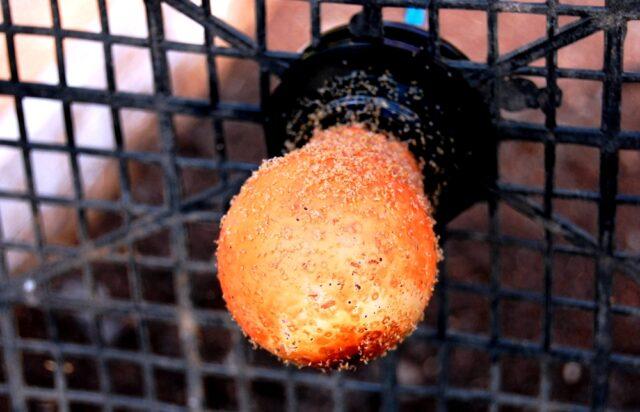
Glowing traps should be hung at the level of cucumber bushes, since the whitefly does not fly high
How to kill whiteflies on cucumbers using folk remedies
If the whitefly has already attacked the cucumbers, then using traps will not give the full effect. In this case, it is recommended to use one of several popular homemade solutions:
- Vinegar. In 1 liter of water you need to dilute a large spoon of essence 70% and stir thoroughly. Cucumbers are sprayed with the resulting product until the whitefly and its larvae disappear. The vinegar solution prevents the return of pests due to its pungent odor.
- Tobacco.About 50 g of dried leaves are crushed, poured with 500 ml of boiling water and left for five days to infuse. The remedy for whiteflies on cucumbers is filtered, and then the plantings are sprayed once every three days until the insect is completely eliminated.
You can make a tobacco infusion based on the contents of cigarettes
- Soap. Pour about 3 liters of warm water into a large container. Laundry or tar soap is grated in a volume of 500 g and stirred in the liquid until smooth. Cucumbers are sprayed with the mixture once a week.
The soap solution is convenient because it forms a protective film on the leaves of cucumbers.
- Garlic. A small head of 5-6 cloves is crushed into a pulp and 3 liters of water are poured in, and then placed in a dark place for a day. The finished infusion is filtered and used for spraying three times a day once a week.
Garlic infusion is safe for cucumbers and humans, but repels pests well
- Home remedies help destroy both the adult greenhouse whitefly on cucumbers and the larvae. In addition, spraying serves as a good prevention of the reappearance of the insect.
You can spray cucumbers with folk remedies, including during flowering and fruiting.Biological agents
You can treat cucumbers against whiteflies in a greenhouse not only with home remedies, but also with purchased biological preparations. Such insecticides contain beneficial fungi that suppress adult pests and larvae of the pest:
- Verticillin. The biological preparation in an amount of 100 ml is diluted in 10 liters of water. The resulting product is sprayed on cucumbers four times in a row at intervals of 10-12 days. The drug should be applied to the lower surface of the leaves; it is advisable to also treat the soil under the bushes.
In addition to whiteflies, Verticillin destroys thrips and spider mites on cucumbers
- Fitoverm. To prepare a medicinal solution, 100 ml of the product must be diluted in 10 liters of water. Spraying is carried out at intervals of 2-3 weeks, special attention is also paid to the back side of the plates.
Fitoverm is recommended as an initial drug to combat whitefly
An unusual biological way to get rid of white midges on cucumber leaves is to plant marigolds in a greenhouse. These flowers attract ladybugs and lacewings, which are natural enemies of whiteflies.
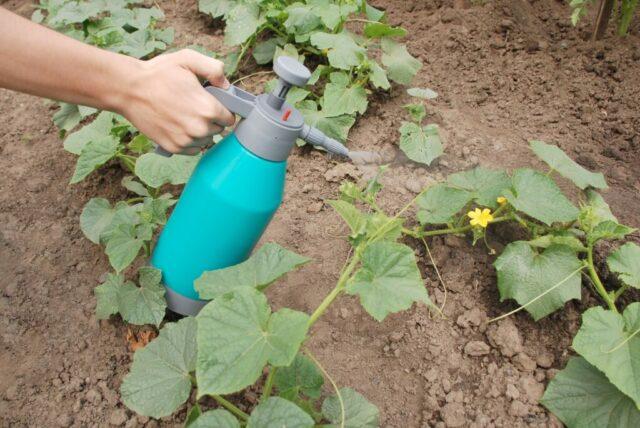
Biological solutions do not harm ripening cucumbers and do not affect the quality of the crop
Chemicals
Chemical insecticidal preparations reliably help get rid of whiteflies. Among the most popular are:
- Aktara. About 4 g of the product is diluted in 10 liters of water and sprayed on the plantings once every 2-4 weeks. The drug not only removes adult whiteflies and their larvae from the leaves, but also forms a protective layer on the plates that prevents the pest from re-attacking the bushes.
Aktara contains the poison thiamethoxam.
- Fufanon. For cucumbers, you need to dilute about 10 ml of the product in 10 liters of water. In a greenhouse, it is enough to spray the bushes once; in open ground, repeat treatment is carried out two weeks after the first.
The main active ingredient of Fufanon is the toxin malathion.
- Boric acid. To eliminate white midges on cucumbers in a greenhouse, you need to dilute about 5 g of the product in 12 liters of water, stir and spray the plantings, paying special attention to the underside of the leaves.Boric acid not only helps to destroy the pest, but also serves as a useful fertilizer.
Spraying with a solution of boric acid should be done in a protective mask and goggles, despite the low concentration
The main disadvantage of chemicals is that it is undesirable to use them to remove whiteflies from cucumbers during the fruiting period. Toxic substances can accumulate in ripening vegetables. Therefore, spraying is stopped 3-4 weeks before harvest.
How to treat cucumbers against whitefly in open ground
In open ground, white midges most often appear on cucumbers as a result of infection at the seedling stage. Even before transferring the seedlings to the garden, it is necessary to carefully examine the leaves for insects or larvae.
If the whitefly attacked cucumbers in open ground already at the growth stage, the following drugs can be used for treatment:
- Spark Bio. Dilute 100 ml of the product in a bucket of water and spray the plantings several times in a row with breaks of 3-4 weeks.
Iskra Bio belongs to the category of low-toxic drugs for humans and animals
- Bud. The insecticidal preparation is dissolved in 10 liters of liquid in a volume of 10 g and the bushes are treated approximately once every ten days.
The bud not only increases the resistance of cucumbers to pests in open ground, but also improves fruiting
Before using medicinal products, it is advisable to wash off the pest from cucumber plantings with plain water. The soil under the plant should be loosened 2 cm deep so that possible pupae and larvae appear on the surface and also come under the influence of the drugs.
Treatment of cucumbers against whitefly in open ground has its own characteristics. Spraying should be carried out in dry and warm, windless weather without bright sun.It is best to perform the procedures in the morning before ten o'clock and in the evening after sunset, in which case there will be no burns on the leaves.
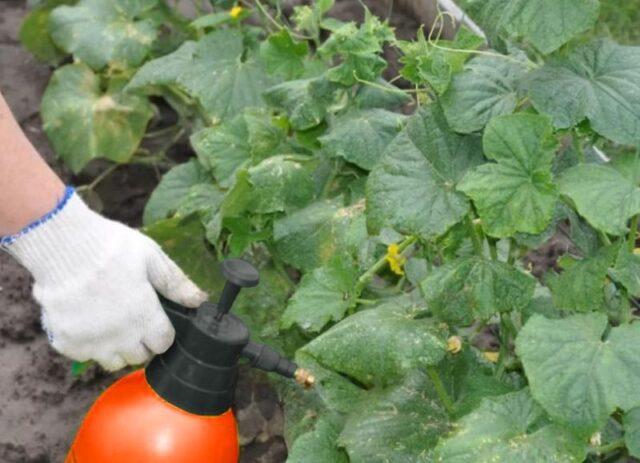
When it rains, cucumbers are not sprayed because the chemicals will be quickly washed away.
Prevention
High-quality pest prevention allows you to avoid a long and difficult fight against whiteflies. To prevent infection of plantings, it is necessary:
- thoroughly disinfect cucumber seeds before sowing by heating or soaking in a solution of potassium permanganate;
- do not over-moisten the soil and regularly ventilate the seedlings;
- maintain the temperature in the greenhouse within 22-24 °C and humidity around 75-85%;
- provide regular access of fresh air to the greenhouse;
- Weed the cucumber beds weekly to remove weeds and loosen the soil;
- Inspect the leaves from time to time to detect whiteflies in time.
After harvesting, it is recommended to spill the soil in the greenhouse with copper sulfate or a pink solution of potassium permanganate for disinfection. In winter, the soil is frozen - at temperatures below -12 ° C, whitefly larvae and pupae waiting out the cold in the ground die.
Conclusion
Whitefly on cucumbers damages the crop and slows down the development of bushes. You can get rid of the pest manually, using traps or spraying. Which method to choose depends on the degree of damage to the plantings and the stage of the growing season.
Reviews on the fight against whitefly on cucumbers in a greenhouse and in open ground
